
|
|
Font Size:
|
||||
|
|
|
|
||||
STATISTICAL BRIEF #473:
Behavioral Medication Utilization in Children and Teenagers Ages 5–18 in the U.S. Civilian Noninstitutionalized Population, 2012
Highlights
- In 2012, 4.2 percent of children and teenagers ages 5–18 took one or more behavioral medications (2.42 million of 58.35 million children and teenagers).
- The percentage of boys ages 5–18 taking one or more behavioral medications was more than double the percentage of girls ages 5–18 taking one or more behavioral medications (6.0 percent versus 2.3 percent) in 2012.
- Children and teenagers ages 5–18 with public only insurance and those with any private insurance were more likely to take one or more behavioral medications (4.9 percent and 4.0 percent, respectively) compared with uninsured children and teenagers (1.0 percent) in 2012.
Introduction
This Statistical Brief presents 2012 estimates of the percentage of children and teenagers ages 5–18 in the U.S. civilian noninstitutionalized population taking one or more behavioral medications by select person characteristics. Behavioral medications were defined as medications having a Cerner Multum therapeutic class code of psychotherapeutic agents (242) or a Cerner Multum therapeutic subclass code of CNS stimulants (71), or anxiolytics, sedatives, or hypnotics (67), or antiadrenergic agents, centrally acting (44). All differences between estimates discussed in the text are statistically significant at the 0.05 level.Findings
In 2012, 4.2 percent of children and teenagers ages 5–18 in the U.S. civilian noninstitutionalized population took one or more behavioral medications (2.42 million of 58.35 million children and teenagers, data not shown) with 4.7 percent of those ages 12–18 taking one or more behavioral medications and 3.5 percent those ages 5–11 taking one or more behavioral medications.In 2012, the percentage of white non-Hispanic children and teenagers ages 5–18 taking one or more behavioral medications (5.3 percent) was more than double the percentage of Hispanic (2.2 percent) and other non-Hispanic children and teenagers (2.1 percent) taking one or more behavior medications (figure 2). Moreover, black non-Hispanic children and teenagers ages 5–18 had a higher likelihood of taking one or more behavioral medications (4.3 percent) compared with Hispanic and other non-Hispanic children and teenagers ages 5–18.
Male children and teenagers ages 5–18 had a higher percentage taking one or more behavioral medications (6.0 percent) than female children and teenagers ages 5–18 (2.3 percent) in 2012 (figure 3).
Comparing children and teenagers ages 5–18 using one or more behavioral medications by poverty status in 2012, there were no significant differences (figure 5). Comparing by region, children and teenagers ages 5–18 in the Midwest (5.4 percent) versus those in the West (2.8 percent) were more likely to use one or more behavioral medications (figure 6).
Data Source
The estimates in this Statistical Brief are based upon data from the MEPS 2012 Full Year Consolidated Data File (HC-155) and 2012 Prescribed Medicines File (HC-152A).Definitions
Behavioral medicationsBehavioral medications were defined as medications having a Cerner Multum therapeutic class code of psychotherapeutic agents (242) or a Cerner Multum therapeutic subclass code of CNS stimulants (71), or anxiolytics, sedatives, or hypnotics (67) or antiadrenergic agents, centrally acting (44). Children and teenagers were defined as taking a behavioral medication if a medication in any of these therapeutic classes/subclasses was purchased for them during the year.
Age
Age was defined using the last available age in 2012 for each sampled person.
Race/ethnicity
Classification by race/ethnicity was based on information reported for each family member. Respondents were asked if each family member's race was best described as American Indian, Alaska Native, Asian or Pacific Islander, black, white, or other. They also were asked if each family member's main national origin or ancestry was Puerto Rican; Cuban; Mexican, Mexicano, Mexican American, or Chicano; other Latin American; or other Spanish. All persons whose main national origin or ancestry was reported in one of these Hispanic groups, regardless of racial background, were classified as Hispanic. Since the Hispanic grouping can include black Hispanic, white Hispanic, Asian and Pacific Islanders Hispanic, and other Hispanic, the race categories of black, white, Asian and Pacific Islanders, and other do not include Hispanics. MEPS respondents who reported other single or multiple races and were non-Hispanic were included in the other category. For this analysis, the following classification by race and ethnicity was used: Hispanic (of any race), non-Hispanic blacks single race, non-Hispanic whites single race, and non-Hispanic others.
Health insurance status
Individuals were classified in the following three insurance categories, based on household responses to health insurance status questions:
- Any private health insurance: Individuals who, at any time during the year, had insurance that provides coverage for hospital and physician care (other than Medicare, Medicaid/CHIP, or other public hospital/physician coverage) were classified as having private insurance. Coverage by TRICARE (Armed Forces-related coverage) was also included as private health insurance. Insurance that provides coverage for a single service only, such as dental or vision coverage, was not included.
- Public coverage only: Individuals were considered to have public coverage only if they met both of the following criteria: 1) they were not covered by private insurance at any time during the year, and 2) they were covered by any of the following public programs at any point during the year: Medicare, Medicaid/CHIP, or other public hospital/physician coverage.
- Uninsured: The uninsured were defined as people not covered by private hospital/physician insurance, Medicare, TRICARE, Medicaid/CHIP, or other public hospital/physician programs at any time during the entire year or period of eligibility for the survey.
Sample persons were classified according to the total yearly income of their family. Within a household, all people related by blood, marriage, or adoption were considered to be a family. Poverty status categories are defined by the ratio of family income to the federal income thresholds, which control for family size and age of the head of family. Poverty status was based on annual income in 2012. Poverty status categories are defined as follows:
- Poor: Persons in families with income less than or equal to the poverty line, including those who had negative income.
- Near poor: Persons in families with income over the poverty line through 125 percent of the poverty line.
- Low income: Persons in families with income over 125 percent through 200 percent of the poverty line.
- Middle income: Persons in families with income over 200 percent through 400 percent of the poverty line.
- High income: Persons in families with income over 400 percent of the poverty line.
Each MEPS sample person was classified as living in one of the following four regions as defined by the U.S. Census Bureau:
- Northeast—Maine, New Hampshire, Vermont, Massachusetts, Rhode Island, Connecticut, New York, New Jersey, and Pennsylvania.
- Midwest—Ohio, Indiana, Illinois, Michigan, Wisconsin, Minnesota, Iowa, Missouri, North Dakota, South Dakota, Nebraska, and Kansas.
- South—Delaware, Maryland, District of Columbia, Virginia, West Virginia, North Carolina, South Carolina, Georgia, Florida, Kentucky, Tennessee, Alabama, Mississippi, Arkansas, Louisiana, Oklahoma, and Texas.
- West—Montana, Idaho, Wyoming, Colorado, New Mexico, Arizona, Utah, Nevada, Washington, Oregon, California, Alaska, and Hawaii.
About MEPS-HC
MEPS-HC is a nationally representative longitudinal survey that collects detailed information on health care utilization and expenditures, health insurance, and health status, as well as a wide variety of social, demographic, and economic characteristics for the U.S. civilian noninstitutionalized population. It is cosponsored by the Agency for Healthcare Research and Quality and the National Center for Health Statistics.MEPS expenditure data are derived from both the Medical Provider Component (MPC) and Household Component (HC). MPC data are generally used for hospital-based events (e.g., inpatient stays, emergency room visits, and outpatient department visits), prescribed medicine purchases, and home health agency care. Office-based physician care estimates use a mix of HC and MPC data while estimates for non-physician office visits, dental and vision services, other medical equipment and services, and independent provider home health care services are based on HC provided data. Details on the estimation process can be found in Machlin, S.R. and Dougherty, D.D. Overview of Methodology for Imputing Missing Expenditure Data in the Medical Expenditure Panel Survey. Methodology Report No. 19. March 2007. Agency for Healthcare Research and Quality, Rockville, MD. http://www.meps.ahrq.gov/mepsweb/data_files/publications/mr19/mr19.shtml
For more information about MEPS, call the MEPS information coordinator at AHRQ (301) 427-1656 or visit the MEPS Web site at http://www.meps.ahrq.gov/.
References
For a detailed description of the MEPS-HC survey design, sample design, and methods used to minimize sources of nonsampling error, see the following publications:Cohen, J. Design and Methods of the Medical Expenditure Panel Survey Household Component. MEPS Methodology Report No. 1. AHCPR Pub. No. 97-0026. Rockville, MD. Agency for Health Care Policy and Research, 2001. http://www.meps.ahrq.gov/mepsweb/data_files/publications/mr1/mr1.shtml
Cohen, S. Sample Design of the 1996 Medical Expenditure Panel Survey Household Component. MEPS Methodology Report No. 2. AHCPR Pub. No. 97-0027. Rockville, MD. Agency for Health Care Policy and Research, 2001. http://www.meps.ahrq.gov/mepsweb/data_files/publications/mr2/mr2.shtml
Cohen, S. Design Strategies and Innovations in the Medical Expenditure Panel Survey. Medical Care, July 2003: 41(7) Supplement: III-5–III-12.
Ezzati-Rice, T.M., Rohde, F., Greenblatt, J. Sample Design of the Medical Expenditure Panel Survey Household Component, 1998–2008. Methodology Report No. 22. March 2008. Agency for Healthcare Research and Quality, Rockville, MD. http://www.meps.ahrq.gov/mepsweb/data_files/publications/mr22/mr22.shtml
Suggested Citation
Stagnitti, M.N. Behavioral Medication Utilization in Children and Teenagers Ages 5–18 in the U.S. Civilian Noninstitutionalized Population, 2012. Statistical Brief #473. June 2015. Agency for Healthcare Research and Quality, Rockville, MD. http://meps.ahrq.gov/mepsweb/data_files/publications/st473/stat473.shtmlAHRQ welcomes questions and comments from readers of this publication who are interested in obtaining more information about access, cost, use, financing, and quality of health care in the United States. We also invite you to tell us how you are using this Statistical Brief and other MEPS data and tools and to share suggestions on how MEPS products might be enhanced to further meet your needs. Please email us at MEPSProjectDirector@ahrq.hhs.gov or send a letter to the address below:
Steven B. Cohen, PhD, Director
Center for Financing, Access, and Cost Trends
Agency for Healthcare Research and Quality
540 Gaither Road
Rockville, MD 20850
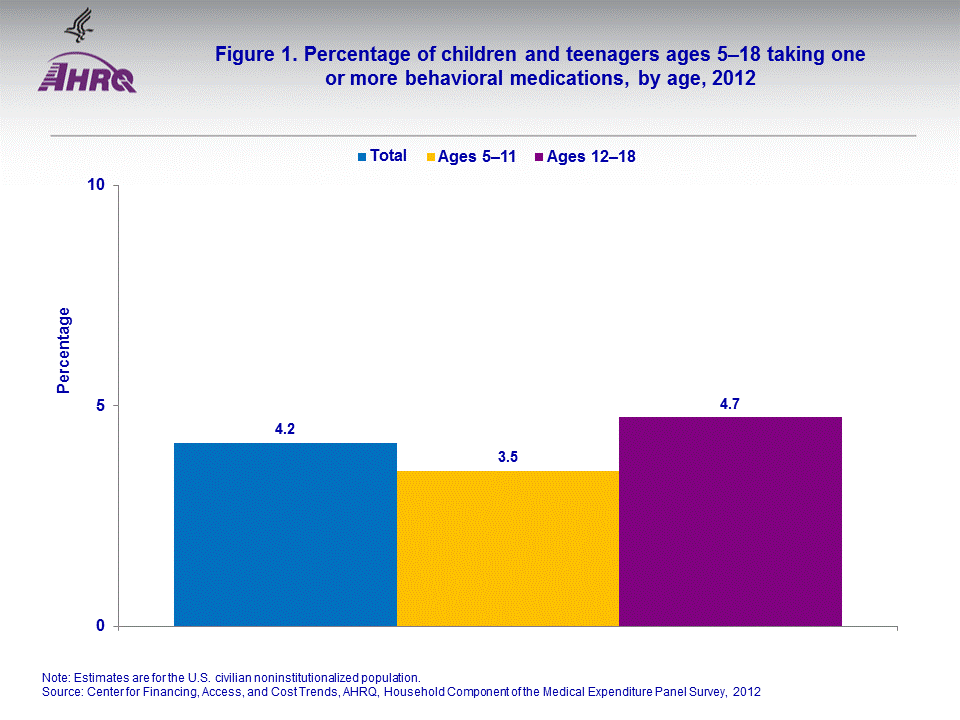 |
|||||||||||||||
|
|||||||||||||||
|
|
|||||||||||||||
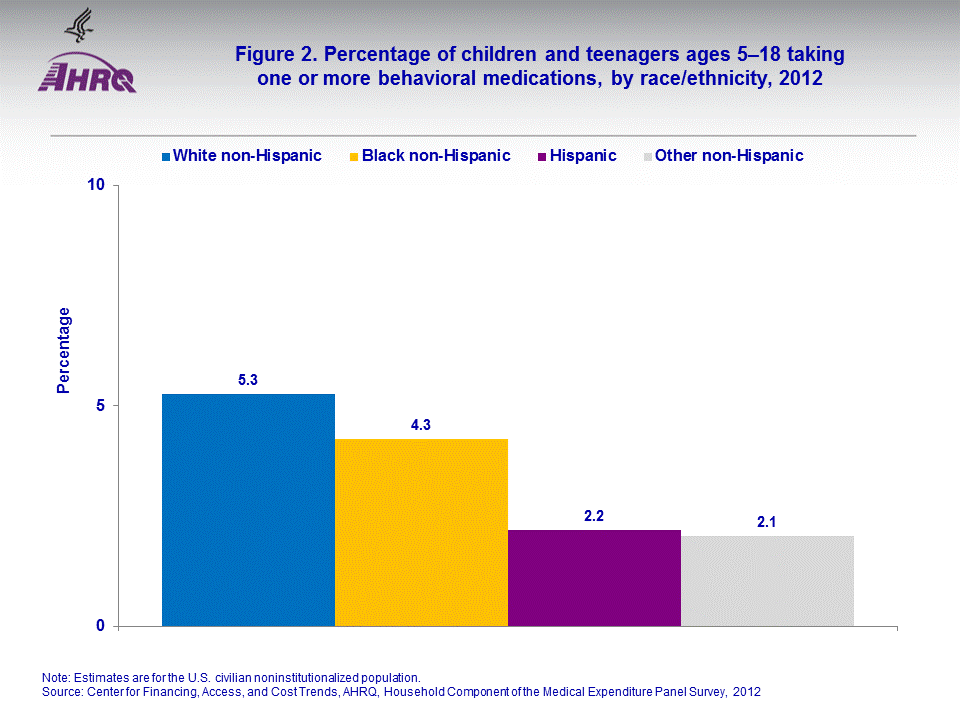 |
|||||||||||||||
|
|||||||||||||||
|
|
|||||||||||||||
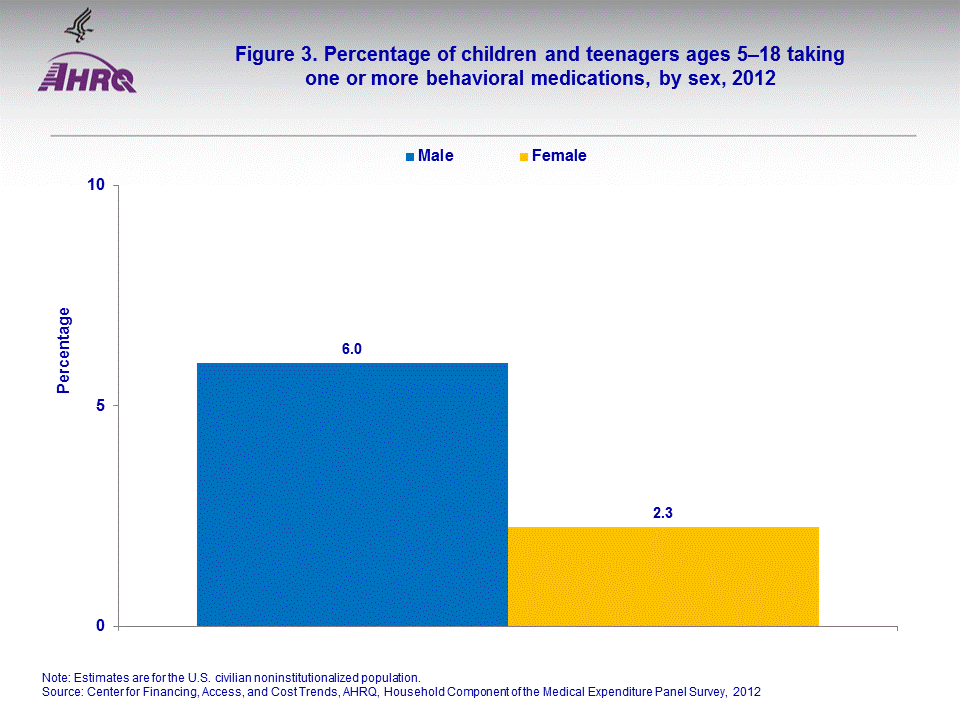 |
|||||||||||||||
|
|||||||||||||||
|
|
|||||||||||||||
 |
|||||||||||||||
|
|||||||||||||||
|
|
|||||||||||||||
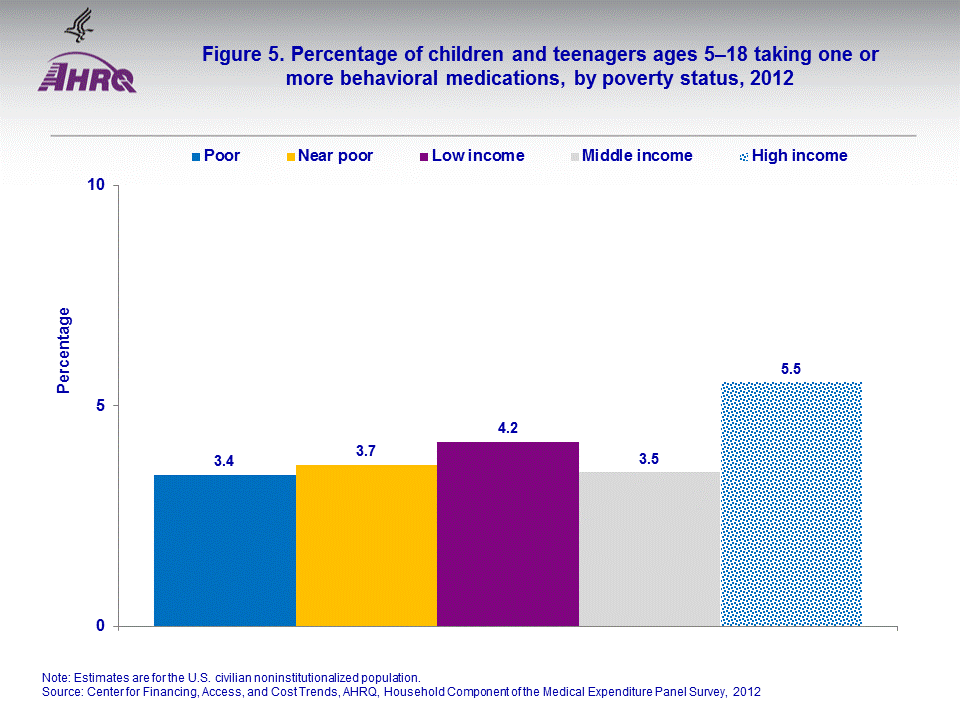 |
|||||||||||||||
|
|||||||||||||||
|
|
|||||||||||||||
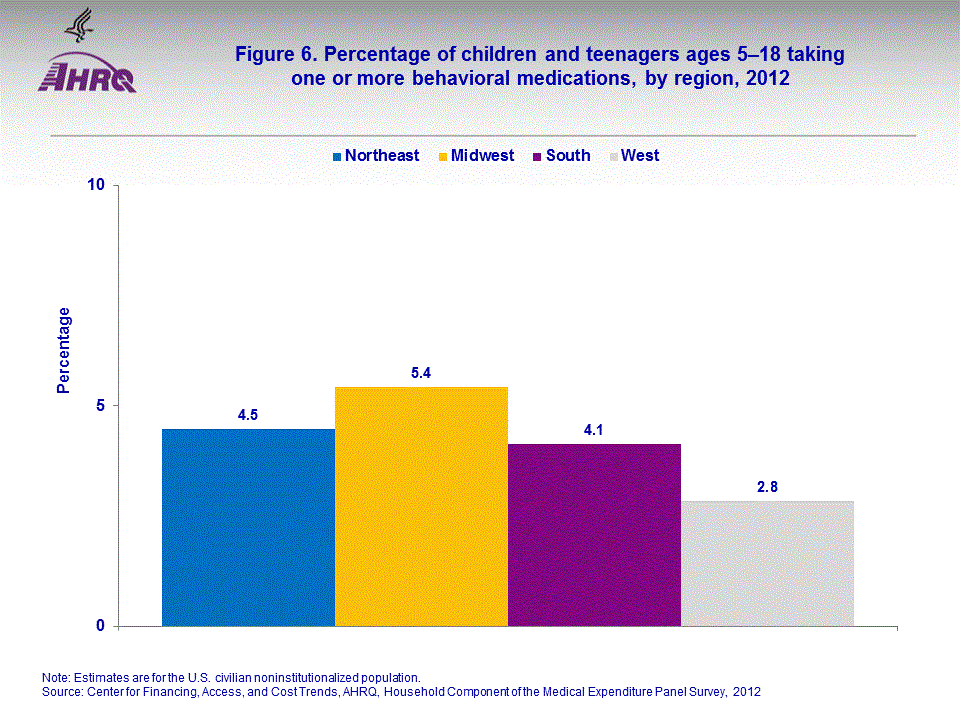 |
|||||||||||||||
|
|||||||||||||||
|
|
|||||||||||||||


